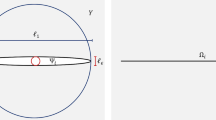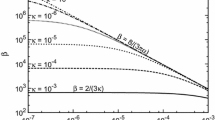Abstract
We establish an exact equivalence of the non-interaction approximation (NIA) and Gassmann theory in describing the changes in effective elasticity due to variations in the bulk modulus of fluid infill of isolated inclusions that have identical shapes and orientations. If the sizes of inclusions (pores or fractures) are equal, the fluid pressures in all inclusionsare equal too regardless of their hydraulic connectivity. This fact makes Gassmann theory rigorous; therefore, other effective media schemes should comply with it when applied to such microstructures. While the NIA satisfies this requirement, other effective media schemes (e.g., self-consistent and differential) do not.
Similar content being viewed by others
References
Biot M.A. (1941). General theory of three-dimensional consolidation. Journal of Applied Physics 12: 155–164
Biot M.A. (1956). General solution of the equation of elasticity and consolidation for a porous material. Journal of Applied Mechanics 78: 91–96
Brown R.J.S., Korringa J. (1975). On the dependence of the elastic properties of a porous rock on the compressibility of the pore fluid. Geophysics 40: 608–616
Eshelby J.D. (1957). The determination of the elastic field of an ellipsoidal inclusion and related problems. Proceedings of Royal Society A241: 376–396
Gassmann, F. (1951). Über die Elastizität poröser Medien. Vierteljahrsschrift der Naturforschende Gesellschaft 96, 1–23 in German; English translation by Berryman, J., Castagna, J., Ecker, C. (2007). On elasticity of porous media. Classics of Elastic Wave Theory, SEG, 389–407.
Mura, T. (1987). Micromechanics of Defects in Solids, Martinus Nijhoff Publishers.
O’Connell R.J., Budiansky B. (1974). Seismic velocities in dry and saturated cracked solids. Journal of Geophysical Research 79: 5412–5426
Sevostianov I., Kachanov M. (2007). Relations between compliances of inhomogeneities having the same shape but different elastic constants. International Journal of Engineering Science 45: 797–806
Thomsen L. (1985). Biot-consistent elastic moduli of porous rocks: Low-frequency limit. Geophysics 50:2797–2807
Vavakin, A.S., Salganik, R. L. (1975). Effective characteristics of nonhomogeneous media with isolated inhomogeneities. Mechanics of Solids, Allerton Press, 58–66 (English translation of Izvestia AN SSSR, Mekhanika Tverdogo Tela 10, 65–75).
Walpole L.J. (1969). On the overall elastic moduli of composite materials. Journal of the Mechanics and Physics of Solids 17: 235–251
Author information
Authors and Affiliations
Corresponding author
Rights and permissions
About this article
Cite this article
Grechka, V. Fluid Substitution in Porous and Fractured Solids: The Non-Interaction Approximation and Gassmann Theory. Int J Fract 148, 103–107 (2007). https://doi.org/10.1007/s10704-008-9188-4
Published:
Issue Date:
DOI: https://doi.org/10.1007/s10704-008-9188-4




